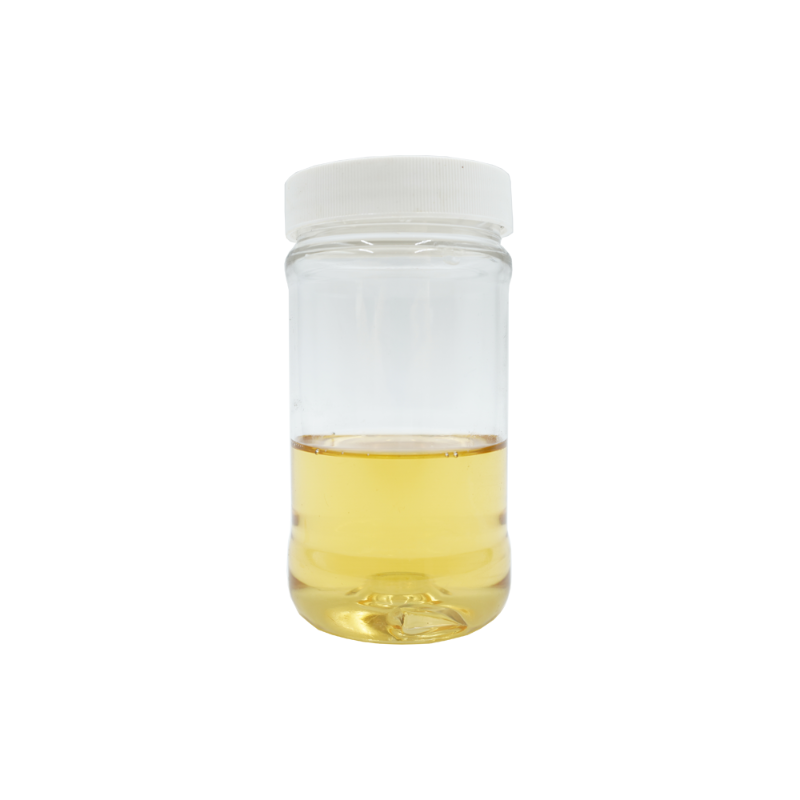-
Categories
-
Pharmaceutical Intermediates
-
Active Pharmaceutical Ingredients
-
Food Additives
- Industrial Coatings
- Agrochemicals
- Dyes and Pigments
- Surfactant
- Flavors and Fragrances
- Chemical Reagents
- Catalyst and Auxiliary
- Natural Products
- Inorganic Chemistry
-
Organic Chemistry
-
Biochemical Engineering
- Analytical Chemistry
- Cosmetic Ingredient
-
Pharmaceutical Intermediates
Promotion
ECHEMI Mall
Wholesale
Weekly Price
Exhibition
News
-
Trade Service
Summary:
The reasons why low-cost polyester powder coatings are prone to shrinkage are analyzed, and it is believed that the relatively high surface tension and the existence of crystallization of low-cost resins may be the main reasons for the poor surface performance of the coating film
On this basis, referring to the basic structure of the wetting aid (701 aid) with a certain anti-cratering function, it is proposed that the introduction of an appropriate amount of active functional groups may help improve the surface properties
A series of methyl methacrylate/butyl acrylate/methacrylic acid (acrylic acid) [MMA/BA/MAA(AA)] terpolymers with different acid values were prepared by solution polymerization, and the structure and performance of the coatings were characterized Online coatingol.
The application of the screened and optimized copolymers to powder coatings can significantly improve the shrinkage phenomenon and meet practical requirements
Compared with traditional solvent-based coatings, powder coatings have environmental protection advantages, but a big disadvantage is that due to the lack of low surface tension solvents, the surface tension of powder coatings is too large, and the wetting of the substrate is not good.
For the shrinkage problem that powder coatings are prone to, it can be solved by synthesizing modified resins or adding some leveling agents and wetting additives
Adding additives can reduce surface tension, but commercial additives are not universal
For example, the low-cost carboxyl-terminated polyester produced by a certain company (hereinafter referred to as resin P), the diol in the raw material is mainly low-cost ethylene glycol, and the pure polyester powder coating prepared by this resin;
Even through the addition of commercial additives (leveling aid 588, wetting aid 701, etc.
In this study, we analyzed this situation, designed and synthesized a polyacrylate additive that is different from commercial additives, evaluated its application, and discussed the mechanism of action between additives and resin
.
1 Experimental part
1.
1 Main raw materials and instruments
Resin P, TS2098 resin: industrial grade, Tiansong; leveling aid 588, wetting aid 701, benzoin: industrial grade, Ningbo Nanhai; Titanium dioxide: industrial grade, Zhongnu Huayuan; precipitated barium sulfate: industrial grade, Nanfeng Group; curing accelerator ethyl-triphenylphosphonium bromide (EPPB): industrial grade, Jiangxi Kent Chemical; methyl methacrylate (MMA), butyl acrylate (BA), methacrylic acid (MAA): Industrial grade, Shanghai Huayi Group
.
Thermal Analyzer (DSC): Swiss Mettler Toledo DSC700; X-ray diffractometer: German Bruker D8; Gel Permeation Chromatography (GPC): American Waters-1515; Contact Angle Meter: German Dataphysics OCA 20; Melt Rotational Viscosity Tester: American BROOKFIELD VISCOMETER DV2T; Damping powder coating extruder: Shandong Haiyang Electrostatic Equipment Co.
, Ltd.
; Spraying equipment: NJPC-2003A, Zhejiang Mingquan Industrial Coating Co.
, Ltd.
; Gelation Time Tester: GT-Ⅲ, Zhejiang American Tec Co.
, Ltd.
Lin'an
.
1.
2 Synthesis of acrylate copolymer
Using the solution polymerization method, the reaction monomers are mainly methyl methacrylate, butyl acrylate and methacrylic acid, and the initiator is azobisisobutyronitrile (AIBN)
.
The polymerization process is as follows: Before the reaction, the required amount of monomer and initiator (AIBN, 2% of the monomer mass) are mixed evenly with magnetic stirring
.
Put xylene in a four-necked flask (to make the concentration of all monomers 50%), after 3 times of air extraction, it is protected with nitrogen
.
The mechanical stirring speed is 200r/min.
After reaching the reaction temperature (outer oil bath temperature of 140°C), the reactants are added dropwise to the flask through the peristaltic pump by continuous dropwise addition, during which the dropping rate is adjusted to maintain a uniform speed as much as possible
.
After the addition is complete, add 0.
5% of the monomer mass initiator, keep the reaction at 140°C for 1 h, first pump out most of the solvent (external oil bath temperature 105°C), and then raise the oil bath temperature to 185°C , First use a water pump, and finally use an oil pump to vacuum dry the remaining solvent and monomer, and vacuum dry in an oven to a constant mass
.
1.
3 Preparation of polyester powder coating
(1) Melt and blend the resin, curing accelerator, and synthesized acrylate copolymer or 701 additive at a certain stirring speed for 30 minutes at 210-220°C, then pour it out, and pulverize after cooling
.
(2) Prepare powder coatings according to the existing formula, containing pigments, fillers and some necessary additives, and then extrude them through a screw machine, pulverize with a pulverizer, and filter through a screen (180 mesh) to obtain a powder with a certain particle size (below 88μm) Particles
.
The temperature of the twin-screw extruder is 90°C in zone I and 120°C in zone II, and the speed is controlled at about 950r/min
.
(3) The steel plate is used as the base material, and the high-pressure airflow blows dry after rust removal and grease removal
.
The powder coating prepared above was sprayed electrostatically, and baked in an oven at 200°C for 15 minutes
.
2 Results and discussion
2.
1 Analysis of the causes of shrinkage in polyester powder coatings
Polyester powder coatings are prone to shrinkage without the aid of low surface tension solvents
.
Generally, the surface tension of commercial powder coating polyester is about 30mN/m, while the surface tension of polyethylene terephthalate (PET) reaches 43mN/m, and the surface tension of tinplate is generally 35~45 mN/m
.
Resin P contains a large number of ET (ethylene terephthalate) structural units.
Compared with other polyester resins, the surface tension is larger and the shrinkage phenomenon is more serious
.
,P(),,,()(
。
TS2098),,P
。
DSCXDCP,
。
。
(1):,,210~220℃240℃,;
(2):,,;
(3):200℃240℃
。
:(1)(3),,
。(2),
。
;,,
。
3,
。
,,P,
。
2.
2
,,
。
701,,,,
。
701,,,,
。
,,P
。
,28 mgKOH/g、72mgKOH/g、112mgKOH/g、224mgKOH/g,Tg45℃,FOX,,1
。
1,,,Mn4300~5300,P,
。
1,,,,
。
3,,MAA2,
。
,γMAA=1.
06,γMMA =0.
10
。,,c,MAA,,,
。
,,,MAA,
。
,,,,a、b、c、d91.
36%、88.
91%、88.
68%、85.
03%,MAA
。
MAA ,,,,MAA,
。
Tg,,Tg,,
。
。
2.
3
P(3.
5%),,2,701,3
。
3,,80 mgKOH/g ,
。
1,701,c
。
,:3.
5%,,;,,
。
,3.
5%
。701,1.
75%3.
5%,,1.
75%
。
cPTS20982
。
2,,PTS2098,
。
,,,,
。
,,
。
c,60°98.
1%,70190.
5%,()
。
。
2.
4 P,
。
。,、Tg=45℃(FOX),,4
。
4,,:
(1);
(2),、,,
。
。,3.
5%,:,
。
b-1,c
。2
。
,150℃P、3.
5%cPc,3
。
c,,P,,150℃,3.
35mN/m,P21.
35mN/m
。
P,3.
5%cP,21.
35mN/m15.
01mN/m
。
。
,2
。,(4)
。
,,;,
。
,,,;,
。
,,
。,P
。
,,,,,,
。
,,,
。
3
,,,
。:
(1) Characterization and analysis of low-cost polyester containing more ethylene glycol, DSC and XRD have not been able to confirm the existence of crystals in the resin, but it is confirmed from the side that the remaining trace crystals or the crystals in the cooling process affect the coating film The surface performance of the product is damaged; from the existing literature, it is also known that its larger surface tension is also the reason for its worse surface performance
.
(2) Design the structure of the surface modification additives, synthesize a series of acrylate copolymers with different acid value content, and mix them into low-cost polyester to evaluate the performance of related powder coatings.
When the acid value content is 80mgKOH /g, the addition amount is 3.
5%, which can effectively eliminate the shrinkage holes in the powder coating, and the surface performance of the sample coating film is equivalent to that of the higher cost sample
.
(3) Discuss the anti-crater mechanism of the additives, and think that it may be the result of the synergistic effect of two factors: ①The carboxyl group in the additive interacts with the carbonyl group in the polyester to inhibit the crystallization of the polyester; ②The acrylate chain The segment has a lower surface tension, can migrate to the surface, reduce the surface tension of the coating, and make it uniform
.






